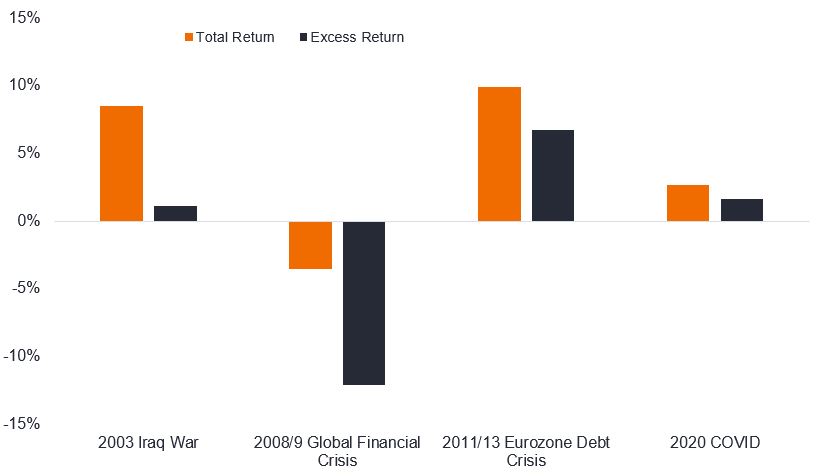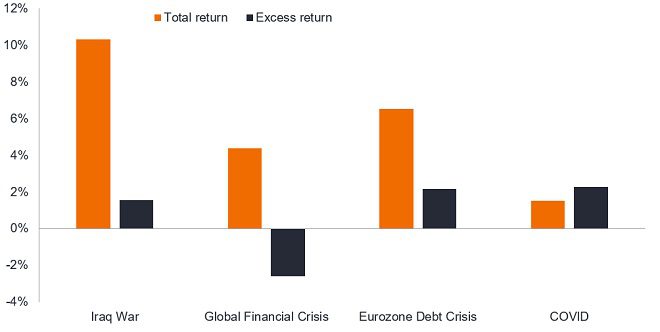Subscribe
Sign up for timely perspectives delivered to your inbox.
Portfolio Managers James Briggs and Tim Winstone look back at previous Eurozone economic downturns for their impact on investment grade corporate bonds and whether parallels exist with today.

Soft or hard? That’s the dilemma facing markets and we’re not talking about cheese. Can central banks engineer a soft landing for the economy or will they provoke a hard landing with a deep recession? We take a look at previous economic downturns in the Eurozone and whether there might be lessons for today’s euro investment grade (IG) corporate bond market.
During the last 25 years the Eurozone has had four contraction/recessionary episodes, as represented by periods of negative quarterly real gross domestic product (GDP) growth. The automatic assumption might be that holding government bonds over corporate bonds would be a good strategy in a period of economic weakness. History suggests that is only true in hard landings.
The four eurozone economic contractions are:
The ICE BofA Euro Corporate Index is a basket of Euro investment grade corporate bonds. Returns data is available for both total return (combined income and capital movements) and excess returns. The excess return isolates the portion of performance that is attributed solely to credit and is equal to the corporate bond(s) total return minus the total return on a risk-matched basket of government bonds. It essentially displays the excess return on an index that comes from the additional yield that corporate bonds accrue over government bonds of the same maturity and the effect of any change in credit spreads over the period.
Figure 1 shows that in three out of the four periods, holding investment grade corporate bonds was more rewarding than holding government bonds. Incidentally, investment grade bonds also outperformed equities (as represented by the MSCI Europe ex UK Total Return Index) in three out of the four periods (the exception being the 2011-13 debt crisis).1

To correct for the fact that recessions do not just start and finish at the same time for all companies, i.e. some corporates will be affected earlier or later by economic weakness, in Figure 2 we expanded the period around the contractions to cover the preceding six months and the following six months. This turns total return positive in all the longer periods and tends to soften the extremes of excess return, i.e. lowers strong positive excess return and reduces negative excess return.

Given the uncertainty in the market about whether we will experience a hard or soft landing, the previous episodes are instructive. They reveal that it has historically made more sense to own investment grade corporate bonds over government bonds in all but the most severe economic contractions.
Of course, each of the four contractionary periods was different. But that can be helpful. We can look for similarities and differences among past contractions compared with today. In the table below we have colour coded green where factors are similar to today.
| Factor at start of contraction | 2003 Iraq War | 2008 Global Financial Crisis | 2011 Debt Crisis | 2020 COVID | 28 February 2023 |
|---|---|---|---|---|---|
| Extent of GDP contraction during downturn | -0.3% | -5.7% | -1.8% | -4.1% | ? |
| Inflation rate | 2.3% | 3.6% | 3.0% | 1.3% | 8.5% (Jan ’23) |
| Inflation falling or rising | Flat | Rising | Rising | Rising | Falling |
| ECB policy rate (refinance) | 2.75% | 4.0% | 1.5% | 0.0% | 3.0% |
| ECB policy rate falling or rising trend | Falling | Rising | Rising | Flat | Rising |
| Effective duration | 4.24 | 4.47 | 3.91 | 5.22 | 4.64 |
| Yield to worst on Euro IG | 4.41% | 5.63% | 4.06% | 0.51% | 4.32% |
| Yields falling or rising | Falling | Rising | Rising | Rising | Rising |
| Credit spread on Euro IG (basis points) | 96 | 179 | 299 | 94 | 147 |
| Unemployment rate | 9.0% | 7.4% | 10.5% | 7.5% | 6.6% (Dec ’22) |
| PMI manufacturing | 48.4 | 52 | 48.5 | 46.3 | 48.5 |
| Price (% of par weight on Euro IG) | 104 | 95 | 100 | 106 | 89 |
Source: Janus Henderson, Bloomberg: Eurozone real GDP at 2010 prices, inflation = Eurozone Harmonised Index of Consumer Prices, year on year % change, European Central Bank (ECB) policy refinancing rate, Eurostat Eurozone unemployment rate, Eurozone Manufacturing Purchasing Manager Index (a figure below 50 indicates contraction); ICE BofA Euro Corporate Index: yield to worst, credit spread = Govt option-adjusted spread (OAS), basis point (bp) equals 1/100 of a percentage point. 1 bp = 0.01%, 100 bps = 1%, effective duration, par weight price (price of a bond as a % of its face value, showing weighted average for the index). Figures in columns consecutively dated as at 31/12/2002, 31/03/2008, 30/09/2011, 31/12/2019 and 28/02/2023 (or latest figure available). Past performance does not predict future returns.
At first glance it looks disparate, but we should expect that as today’s environment is not a perfect match with any of the past contractions. If it were, investing might be a lot easier. The clearest distinction is inflation. In all previous episodes it was either flat or rising. Today it has rolled over and is coming down from a peak but the recent peak was much higher than at the start of previous economic downturns. How quickly it subsides will affect central bank policymaking so it remains a key variable for interest rate risk.
The colour coding in the table ominously has the most commonalities with the 2008 Global Financial Crisis (GFC) recession. Recall this was the downturn that resulted in negative excess return. Today’s yield and spread are below the levels at the start of 2008, which marries with our view that today’s market warrants some caution as it is not pricing in a severe recession. Despite the geopolitical risks emanating from Russia/Ukraine, however, we do not see the same systemic risk within the financial system that existed within the banking sector pre-GFC. Today, the banking sector is better capitalised and the coming downturn in our view is a more traditional economic downturn focused on consumer/corporate retrenchment, which ought to be less severe than a financial crisis.
Today’s yields and spreads are similar or higher than shallow recessions, potentially justifying current market pricing if the economy achieves a soft landing or shallow contraction. Another notable difference is that prices today are well below par values, creating a helpful pull to par. Judging against these parameters, Euro investment grade corporate bonds may be fairly priced for a shallow downturn and potentially offer value if the economy could avoid a recession altogether. Much will rest on how quickly inflation can recede and the response of central banks.
Footnote
1Source: Janus Henderson, Bloomberg, MSCI Europe ex UK, ICE BofA Euro Corporate Index, total returns in USD. Periods as per Figure 1. Past performance does not predict future returns.